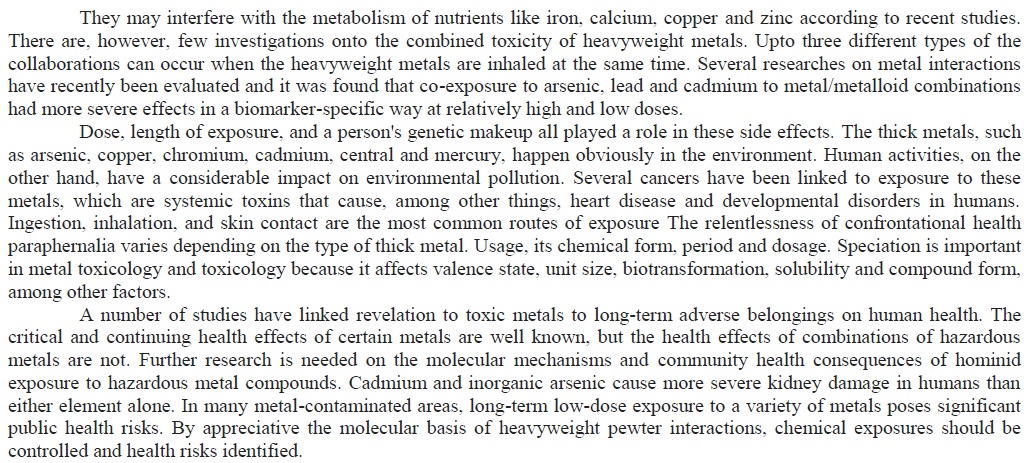Study on Relationship between hexavalent chromium Metal Toxicity on Terrestrial Environment
Keywords:
metal, toxicity, environmentAbstract
Chemical species, dosage, exposure route, and individual differences in genetics and nutritional status are only few of the many elements that go into determining how poisonous a substance is. In terms of potential harm to human health, the following metals should be considered top priorities: arsenic, cadmium, chrome, lead, and mercury due to their severe toxicity. At low levels of exposure, certain metallic elements are considered systemic toxicants. Additionally, the International Agency for the Study of Cancer classifies them as carcinogenic in humans. Toxicology, genotoxicity, and carcinogenicity are all examined in this study, as well as the likelihood of human exposure and the molecular pathways responsible for these compounds' toxic, genotoxic, and carcinogenic effects. Metals with a high submicroscopic weight and concentration greater than five times that of water are known as "heavy metals." There is a great agreement of concern about the likely effects of these chemicals on human health and the environmental result of their widespread usage in a variety of industrial, home, agricultural, pharmaceutical, and technological settings.
Downloads
References
Duffus JH. (2002). Heavy metals-a meaningless term?. Pure Appl. Chem., 74(5), 793–807.
He ZL, Yang XE, & Stoffella PJ. (2005). Trace elements in agroecosystems and impacts on the environment. J. Trace Elem. Med. Biol., 19(2–3), 125–140.
Herawati N, Suzuki S, Hayashi K, Rivai IF, & Koyoma H. (2000). Cadmium, copper and zinc levels in rice and soil of Japan, Indonesia and China by soil type. Bull Env. Contam Toxicol., 64, 33–39.
Murgo AJ. (2001). Clinical trials of arsenic trioxide in hematologic and solid tumors: overview of the National Cancer Institute Cooperative Research and Development Studies. Oncologist, 6(2), 22–28.
Puccetti ES, Guller S, Orleth A, Bruggenolte N, Hoelzer D, Ottmann OG, & Ruthardt M. (2000). BCR-ABL mediates arsenic trioxide-induced apoptosis independently of its aberrant kinase activity. Cancer Res., 60(13), 3409–3413.
Alemany M, & Levin J. (2000). The effects of arsenic trioxide on human Megakaryocytic leukemia cell lines with a comparison of its effects on other cell lineages. Leukemia Lymphoma, 38(1–2), 153–163.
Lu T, Liu J, LeCluyse EL, Zhou YS, Cheng ML, & Waalkes MP. (2001). Application of cDNA microarray to the study of arsenic-induced liver diseases in the population of Guizhou, China. Toxicol. Sci., 59(1), 185–192.

Downloads
Published
How to Cite
Issue
Section
ARK
License
Copyright (c) 2022 Md. Aliullah Suleman

This work is licensed under a Creative Commons Attribution 4.0 International License.
Research Articles in 'Applied Science and Biotechnology Journal for Advanced Research' are Open Access articles published under the Creative Commons CC BY License Creative Commons Attribution 4.0 International License http://creativecommons.org/licenses/by/4.0/. This license allows you to share – copy and redistribute the material in any medium or format. Adapt – remix, transform, and build upon the material for any purpose, even commercially.










